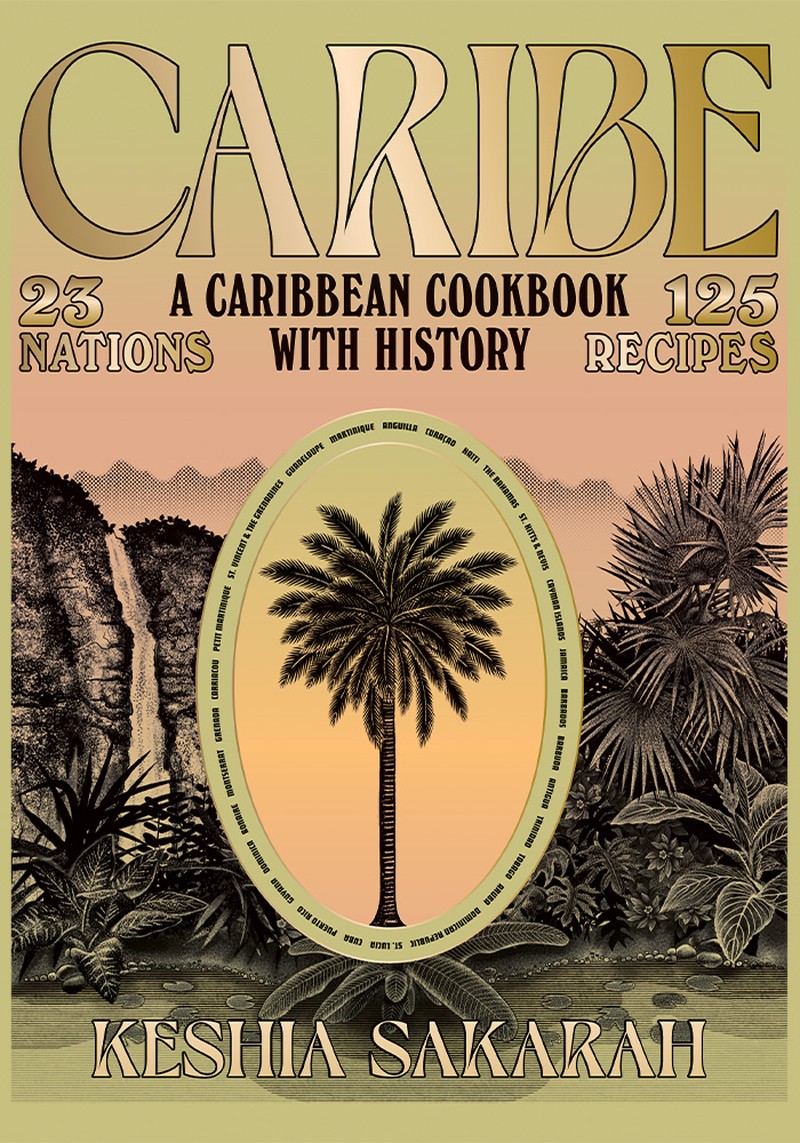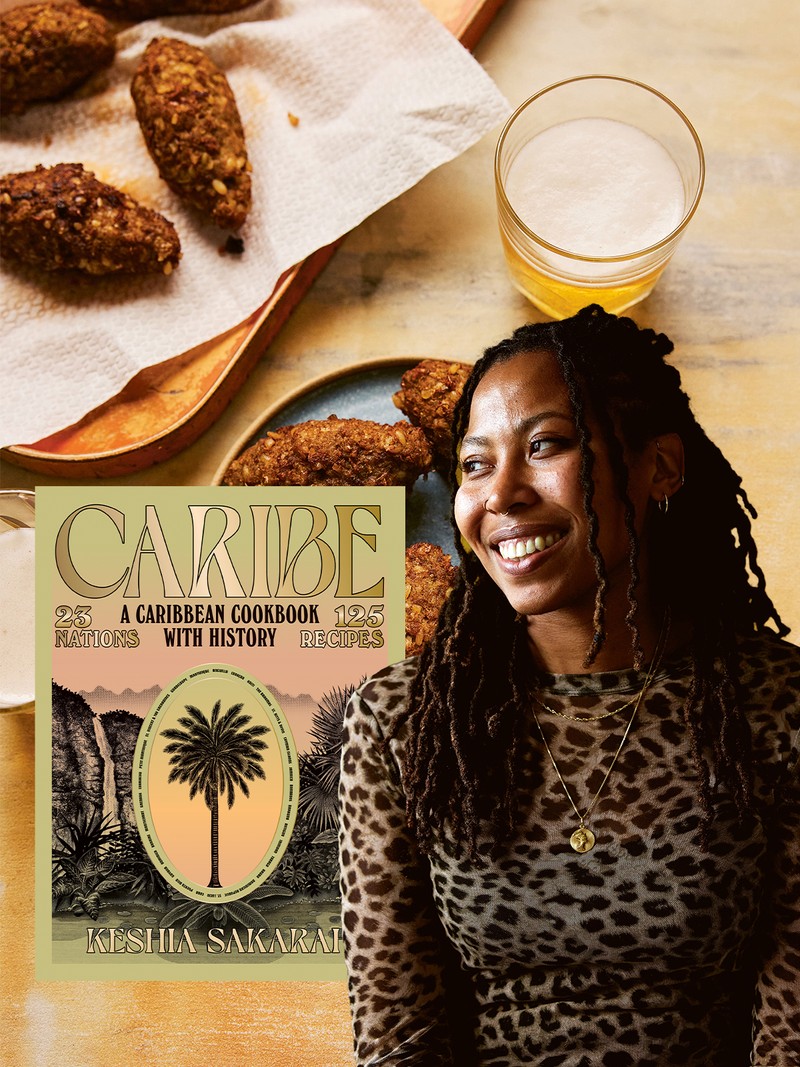
4 Great Caribbean Recipes To Try At Home
I love Dalston’s Ridley Road Market and Brixton Market for fresh groceries. They sell everything I need to make Caribbean food, like pumpkin, green bananas and saltfish. There’s also a lovely store called Ma Soda in Brixton Village, where the owner sells his own dried sorrel (hibiscus) from Senegal, which I use to make sorrel with ginger or tea. For fish, I go to Moxon’s and for meat I like M.Moen & Sons in Clapham because they have a nice variety of good-quality produce.
To make great Caribbean food at home, you need fresh ingredients like thyme, scotch bonnets, garlic, ginger and spring onion. They’re the foundational ingredients and grow in abundance across the islands. Other ingredients include good-quality coconut milk, dried or fresh bay leaves, cloves, cinnamon and allspice (pimento), which are all used in sweet and savoury dishes, from rice and peas to cocoa tea (Caribbean-style hot chocolate).
For an evening with the girls, I’d cook my bake and ‘shark’. It’s not really made with shark but lovely white fish. It’s a cool fried-fish sandwich stuffed in a fried dumpling and loaded with pineapple, sweet and sour chutneys and salad. They’re fun to eat, have lots of flavour and textures, and remind me of time spent in Trinidad. I’d serve this with a fruity rum punch with lots of lime and extra bitters.
My comfort dish is corn soup. It’s silky smooth from the coconut milk, but hearty from the yellow peas. All the extra vegetables, fresh corn and dumplings make it filling. I love Bajan-style hot sauce too. The brand Aunt May’s is iconic for its bright yellow colour and just-right spice level.
My favourite family recipe is my grandma’s plate tart. I’ve made it many times with her from a very young age. She used to make it with her mother in Montserrat before moving to England, so it feels special that the recipe has lived on.
There are some great Caribbean restaurants in London. I love Roti Joupa. They were based in Clapham but have now moved to Stratford. It's a family business that's been going since the early 2000s, with a few branches across London. It’s a great, affordable spot that focuses on dishes from Trinidad, like roti and aloo pie – which is delicious.
I recently went on a trip to Grenada which was glorious. It’s the perfect island for a solo trip or with a group. It’s home to beautiful scenery and varied landscapes, from sulphur springs to waterfalls. The food is so eclectic and accessible, whether it be street food or dishes at family restaurants. I ate everything from pelau rice to creole fish and cou-cou. I’m lucky enough to have visited 15 Caribbean islands, but I would love to explore places in central and south America like Colombia and Mexico.
My travels, and love of history and food, inspired me to write this cookbook. I wanted to create something that celebrated the richness of our culinary culture and heritage. The foodways of the Caribbean are vast, with influences from all over the world. Plus, growing up as second-generation within the Caribbean diaspora in the UK, I’ve written the book I know my younger self would have loved to read – to be inspired by and to learn more about our identity. Recipes and ingredients tell us so much about people, places and time. Including the history with the recipes helps us understand the full context of the Caribbean, which is often not well known or widely recorded.
My favourite recipes in the book are personal to me – Like my grandma’s plate tart or my Uncle Jerry’s fish tea, which both capture a moment of the past. The story of Haiti’s independence soup – Soup Joumou – is particularly special because it symbolises how the Haitian people reclaimed a recipe to commemorate their newfound independence and emancipation. Once forbidden by their French colonisers, the soup now represents their triumph and freedom.
Visit @SAKARAH_
Feeling inspired? Here, Keshia shares four recipes to try…
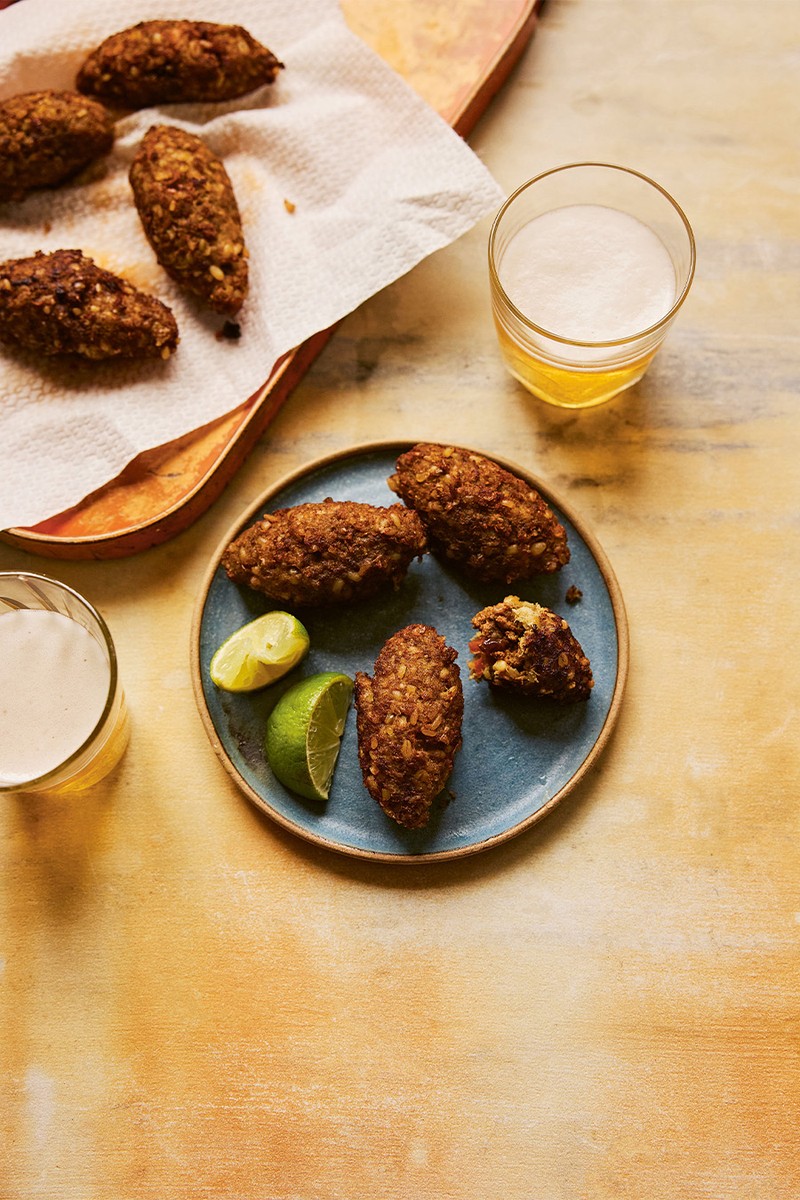
Dominican Lebanese Kibbeh
Kibes or quipes are the Dominican version of the Lebanese kibbeh, which has been a staple across Assyria – present day Palestine – Jordan, Lebanon and Syria for centuries. The word kibbeh evolved from the word kabbab, an ancient Akkadian word, meaning ‘to ball up’. As a result of migration from the Middle East, they are now most commonly found in the eastern and southern parts of the Dominican Republic, where beef is substituted for lamb, and mint, cumin and pine nuts are omitted for oregano, olives and raisins – a reflection of the ingredients found in the local landscape.
Start by soaking the bulgur wheat. Place it in a bowl, then pour over cold water until it is just covered. Leave to soak and absorb the water for at least 4-5 hours.
While the bulgur is soaking, prepare the filling. Heat the oil in a saucepan over a medium heat, then add the beef, onion, chopped pepper, sofrito, salt, pepper and garlic. Fry for 8-10 minutes, or until the meat is almost cooked through and the vegetables are soft, then add the tomato purée and oregano. Continue to cook for a few more minutes until well incorporated, then add the olives, raisins and chadon beni or coriander.
Stir through until well combined, then set aside to cool.
Drain any excess water from the bulgur using a sieve, then transfer to a food processor along with the beef, onion, parsley, salt, black pepper and sofrito. Blend to form a slightly coarse paste. Divide the casing mixture into 16 pieces, then take a piece and spread it flat on the palm of your hand. Spoon about 2 tablespoons of the filling into the centre. Carefully encase the filling by closing the casing around it tightly, creating a cylinder shape and pinching the ends to seal. Ensure it is totally sealed so the filling won’t fall out when frying. Repeat with the remaining filling and casing mixture, placing the kibes on a plate or tray as you go. Transfer to the refrigerator to chill for at least 1 hour before frying.
When you’re ready to fry, pour the oil into a large saucepan over a medium heat and heat to 180°C (350°F). Alternatively, you can test the oil by tearing off a piece of bread and dropping it into the oil. If it sizzles straight away and gradually turns gold brown, the oil is ready. If it turns brown quickly It is too hot. Deep-fry the kibes in batches for 3-4 minutes or until they are brown all over. Serve warm.
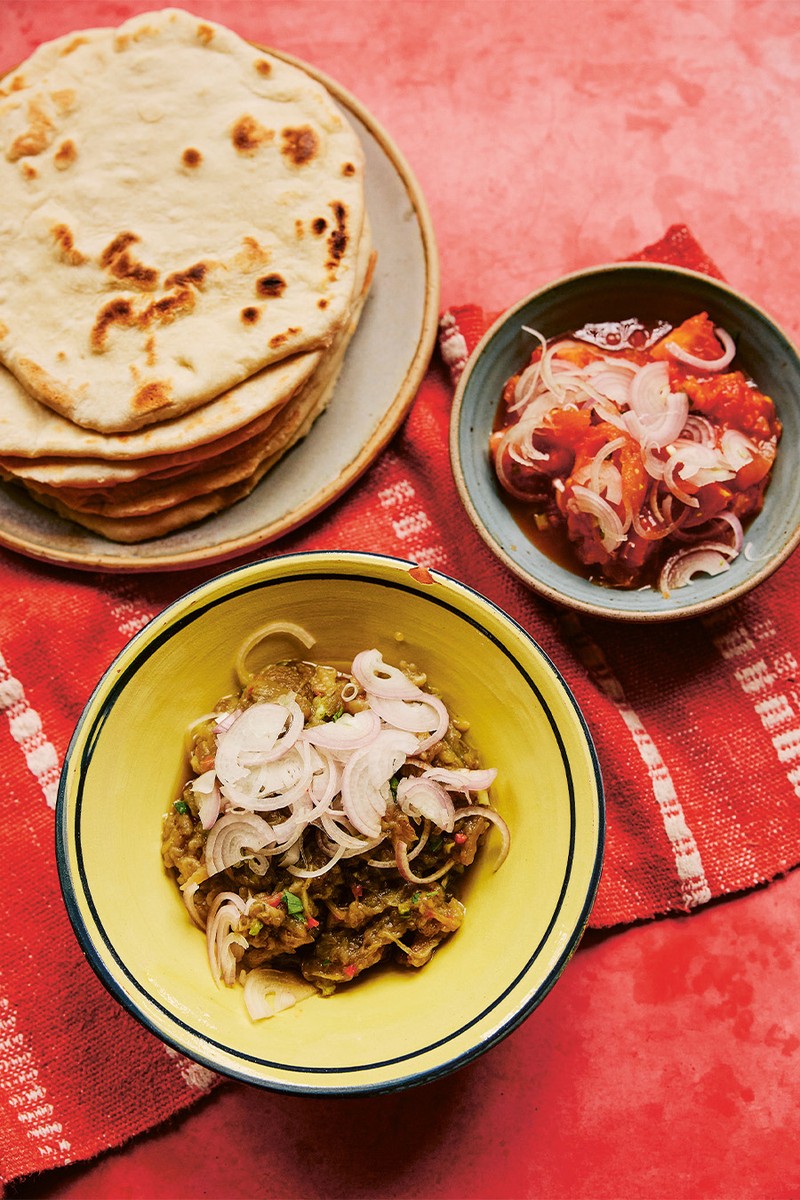
Baigan & Tomato Chokas
Roasting over coals or open fire gives baigan (aubergine) a smoky flavour. When the skin is charred and the middle is soft, it becomes a delicious dish of earthy silkiness. Once roasted, the skin is peeled and the fleshy centre is seasoned with salt, topped with freshly crushed garlic and finely sliced onions, before being chunkayed with hot oil. This dish and method of cooking aubergine – and sometimes tomatoes – is called choka. Chokas are made across India, Pakistan and Bangladesh, and are common across the Caribbean islands among communities with roots in South Asia. Just as they would be in Asia, chokas are served with fresh, hot sada roti (plain roti), most commonly for breakfast.
Put the aubergines and tomatoes onto a baking tray and grill under a high heat, turning occasionally until the skin has blackened and blistered all over, and the flesh is soft. Once cooked, set aside to cool, then peel off the skin and discard it, retaining the cooked flesh.
Put the tomatoes and aubergines into separate bowls, then crush with a spoon or fork to break up the flesh. Add the Scotch bonnet, garlic, coriander or chadon beni and salt to each bowl, mixing well. Divide the shallots between the two bowls, sprinkling them on top.
To chunkay, heat the oil in a small saucepan over a medium heat. Once hot, carefully pour the oil over the shallots on top of the aubergines and tomatoes. It will immediately sizzle and react with the vegetables. To finish, stir in the oil and shallots. Serve with the sada roti.
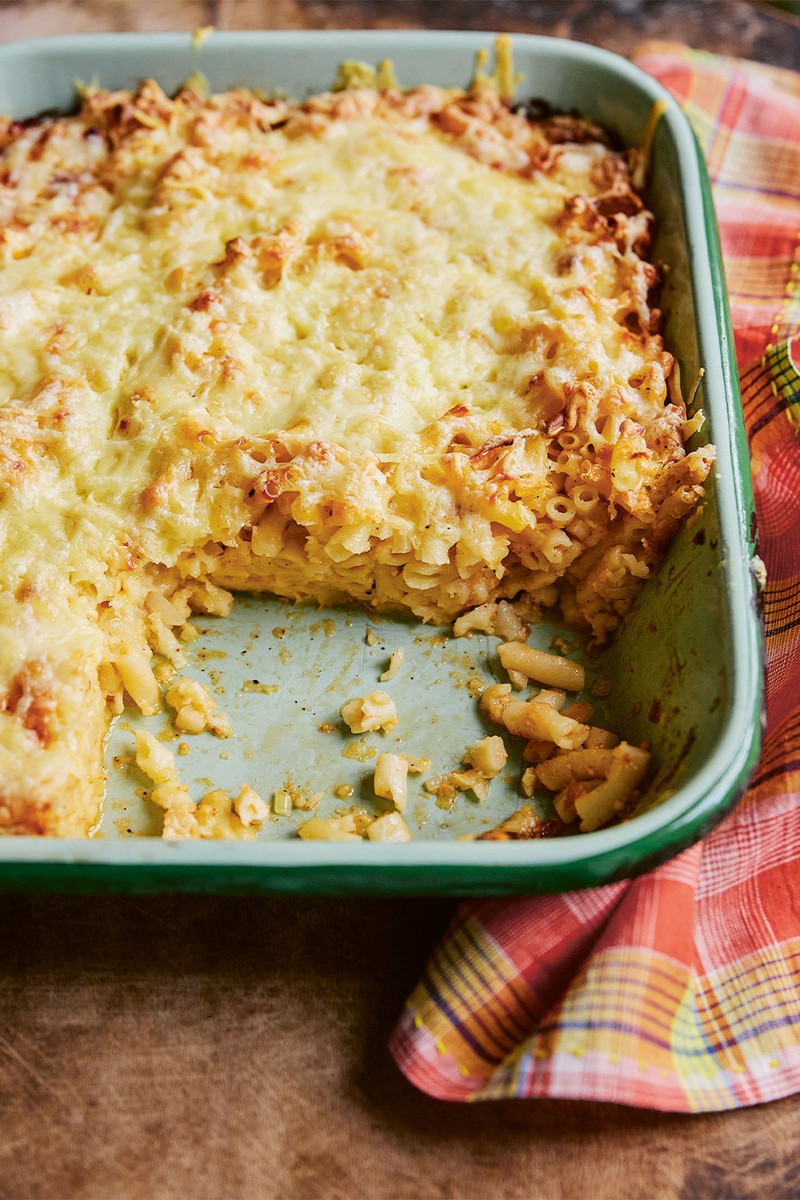
Macaroni Pie
Haitians call this dish macaroni au gratin. I grew up hearing this called macaroni and cheese by my grandma, and much of the region and diaspora in the UK and US call it macaroni pie – either way it’s delicious, especially for Sunday lunch. The first known recording of macaroni pie is said to have been in Barbados in the 1700s. The connection between macaroni cheese and the Caribbean is a really slim one and is likely one that was introduced through the movement of people across the islands to North American colonial lands. On one of his visits to Europe, Thomas Jefferson (the third president of the US) took a liking to this dish. Story has it that his personal chef James Hemming – the ‘ghost of America’s kitchen’, an enslaved African American – travelled with him and is said to have brought the dish over from France or Italy, further developing the recipe and introducing it to the culinary landscape of the Americas.
Preheat the oven to 170°C fan (375°F).
Bring a large saucepan of water to the boil and add 1 teaspoon of the salt, then add the pasta and cook according to the packet instructions. Drain, then rinse with cold water to stop the cooking process.
Mix together the tomato ketchup, hot pepper sauce, nutmeg, remaining salt, pepper, onion, garlic, cornflour, egg, mayonnaise and milk in a large bowl. Whisk until well combined, then stir in 350g of the mature cheddar and 250g of mozzarella cheese.
Once everything is well incorporated, add the cooked pasta and mix again. Pour the mixture into a baking dish, then sprinkle with the remaining cheese. Cover with a layer of baking parchment, then foil. Seal tightly and bake in the oven for 40-50 minutes.
After this time, carefully remove the foil and parchment, then return to the oven and cook for a further 20-25 minutes, or until set and golden brown on top. Remove from the oven and allow to cool slightly before slicing into blocks.
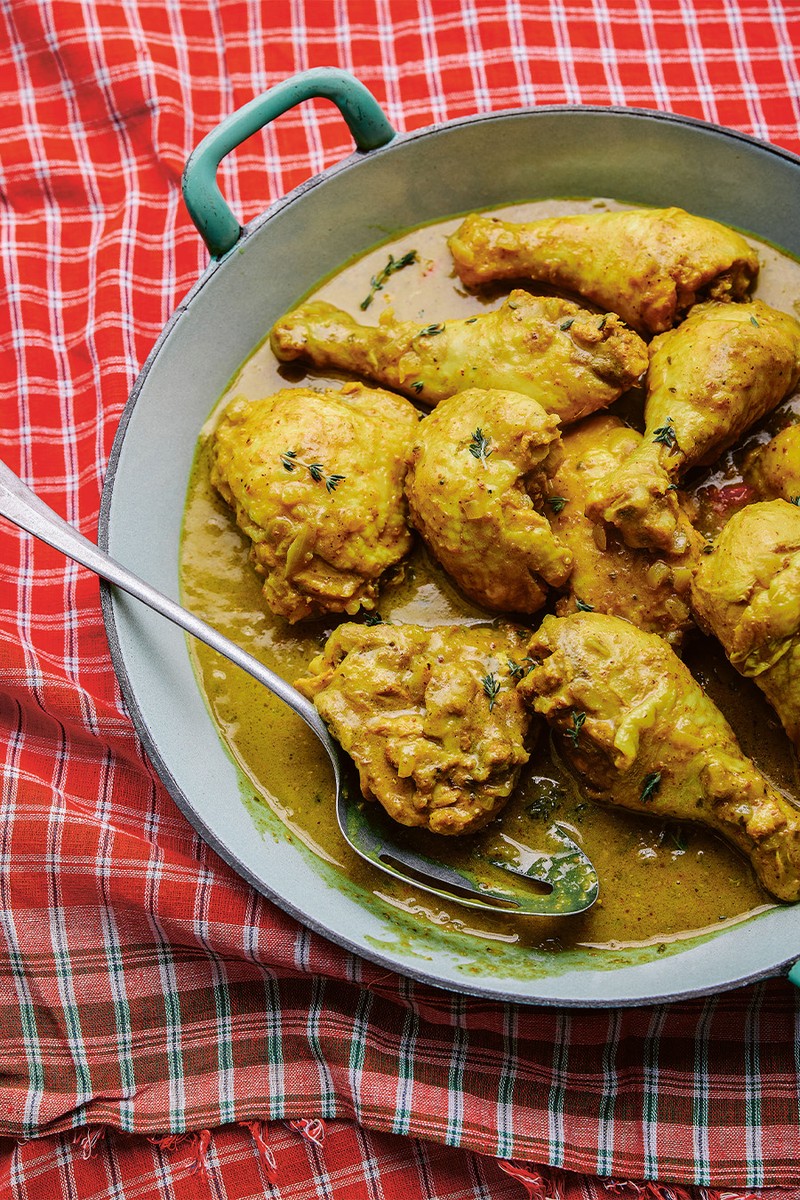
Colombo
Indo-Martiniquans and Indo-Guadeloupeans make up approximately 10% of the population on those islands. They are mostly descended from indentured labourers that arrived during the 1800s. A recipe introduced to the islands by this community is colombo. It is said to have derived from the Tamil word kulambu, which references curry. The recipe has a unique addition of roasted, uncooked rice added to the whole spices before being ground, making the sauce thicker and richer. On my travels, I tried colombo from a small, casual eating place in Guadeloupe. It was lightly spiced, and the sauce was thick with a strong citrusy flavour from the added lime juice. Sometimes courgette and aubergine are added to the sauce.
First, make the spice mix. Heat a dry frying pan over a medium heat, then add all the ingredients except the turmeric. Toast in the pan for no more than a minute to ensure they don’t burn. The pan will smoke a little and you will be able to smell the spices toasting. Remove from the heat and transfer to a spice grinder or pestle and mortar along with the turmeric, then grind to a fine powder.
Next, put the chicken into a bowl along with the lime juice, thyme, garlic, Scotch bonnet, salt and 3 tablespoons of the spice mix. Mix well to ensure everything is coated, then cover and set aside in the refrigerator to marinate for a few hours, or overnight.
As you’re getting ready to cook, remove the marinated meat from the refrigerator and set aside for 30 minutes to allow to come to room temperature.
Heat the oil in a saucepan over a medium-high heat, then add 3 tablespoons of the colombo spice mix and cook in the oil for a few minutes. Pour in the water, add the onions then simmer for 3-4 minutes before adding the chicken. Mix the chicken into the spices, then reduce the heat slightly and cook for a few minutes, allowing the meat to release its juices. Next, add the coconut milk, increase the heat slightly and bring to a low boil. Once bubbling, add the aubergine, courgette or chayote (if using), reduce to a simmer, cover and cook for 40-50 minutes, or until the meat is tender. Serve with white rice.
Caribe by Keshia Sakarah (Quadrille) is available to buy on 20th March.
Available soon at AMAZON.CO.UK
Photography by: Matt Russell
DISCLAIMER: We endeavour to always credit the correct original source of every image we use. If you think a credit may be incorrect, please contact us at info@sheerluxe.com.

